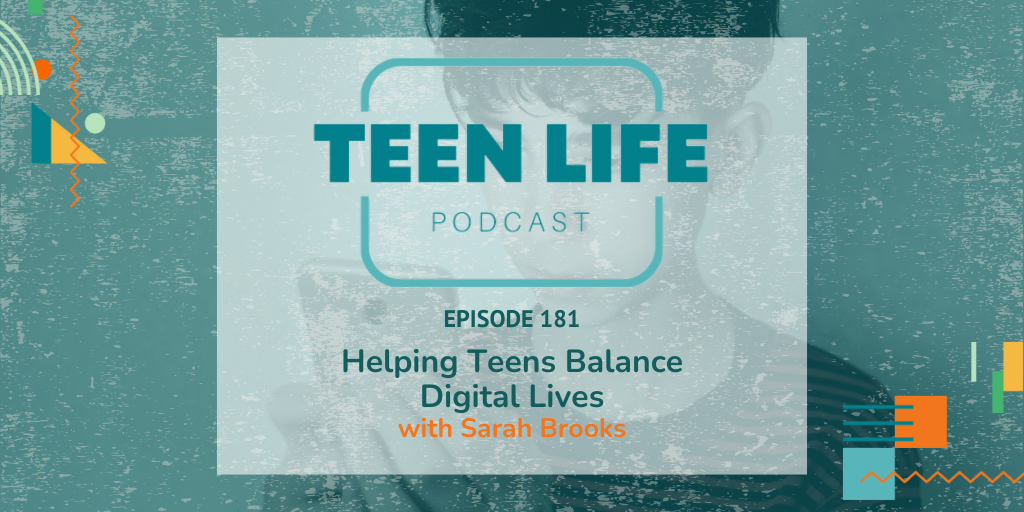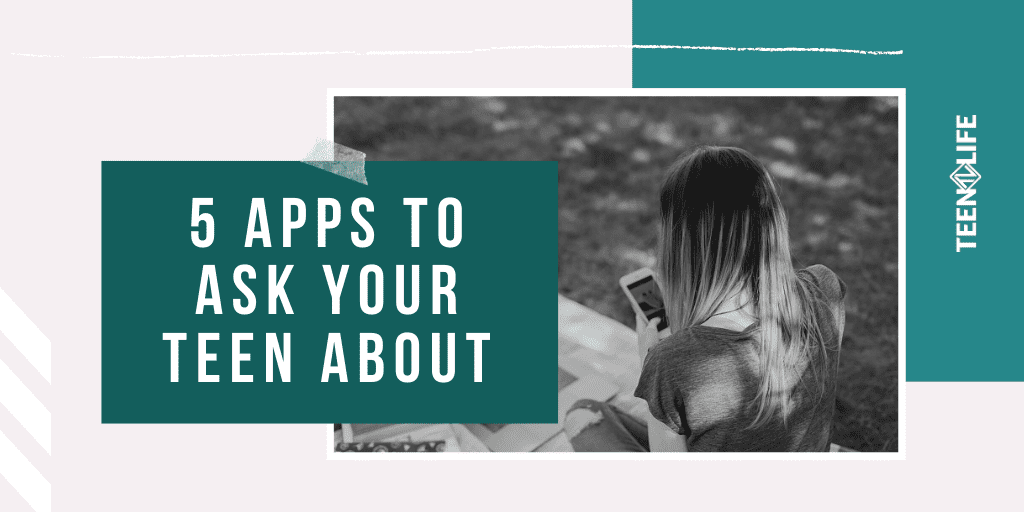
Helping Teens Balance Digital Lives with Sarah Brooks | 181
Podcast: Play in new window | Download
How can I help teens grow in gratitude?
Our phones never stop buzzing, but today’s teens need more than constant connection. In this episode, the team welcomes Sarah Brooks, longtime Teen Life volunteer and board member, to explore a question many parents, teachers, and mentors are asking: How can adults help teens keep their digital lives in balance?
Key Question
What are ways that adults can help teens balance their digital lives?
What We Cover
00:00 Navigating Digital Life and Social Media
00:27 The Positive Aspects of Digital Connection
06:38 The Dark Side of Digital Engagement
14:18 Finding Balance in a Digital World
What are the bright spots in the digital world?
Digital life isn’t all bad. Online spaces can offer connection for young people who feel isolated, especially those with unique interests or social anxiety. Creative teens also have powerful tools to share music, art, and ideas with a wide audience. These opportunities can spark friendships and encourage imagination—when used with care.
Yet even these positives carry a shadow—constant shallow connection, pressure to “be a brand,” and the loss of simply doing something for fun.
TL;DR: Things to Celebrate
-
Connection for the Isolated
-
Space for Creativity
What should we be worried about?
The constant scroll brings real concerns. Device use can become addictive, with withdrawal-like reactions when screens are taken away.
Short attention spans are now the norm, making it harder to engage deeply with sports, schoolwork, or relationships.
Teens are also exposed to rapid swings from tragedy to celebration, leaving them numb and emotionally drained. And when life is shared mainly as content, in-person moments can lose their meaning.
Practical Ways to Support Balance
Caring adults can help guide teens toward healthier habits:
Model healthy limits.
Let them see you step away from your phone—during meals, on outings, or for set periods each week.
Invite their input.
Ask what they think a reasonable screen schedule looks like. When teens help set boundaries, they’re more likely to follow them.
Offer real-life alternatives.
Outdoor time, hobbies, and even boredom give teens a chance to reset.
Use tools thoughtfully.
Apps or devices that limit screen access can be helpful, but conversation and connection matter even more.
Some Last Thoughts
Technology is a powerful tool, but it should serve us—not the other way around. By modeling balance, involving teens in the process, and encouraging offline experiences, adults can help young people enjoy the benefits of digital life without being consumed by it.
We’re all learning together—one unplugged moment at a time.
Read Episode Transcript
Sarah: I’ve been in the digital space for about 15 years, and when I first started, I had a long list of positives. Over time that list has gotten shorter. Even when I see positives, the negative side grows stronger. But yes, there are still a few.
Connection is huge, especially for kids who find it hard to connect face-to-face. A teen with a specific hobby or unique skills can find others around the world who share that interest without the pressure of in-person interaction. That will always be a positive. The downside is that we’re now so over-connected that we don’t know how to unplug.
Creativity is another benefit. Teens can create music, art, and content in ways that were impossible before. But many start to see themselves as a brand. They feel pressure to maintain a certain image and “top” their last post. Humans weren’t meant to have an aesthetic, and that constant pressure can take the fun out of being creative.
Host: It’s like how a fun hobby quickly turns into something you have to monetize.
Sarah: Exactly. We rarely do things just for fun anymore.
Host: On the flip side, what are the most concerning patterns you see with teens and digital life?
Sarah: The physiological and neurological addiction. The dopamine hit is real. When devices are taken away, many kids show actual withdrawal symptoms. We also have clear data now showing how constant screen time harms mental health.
Attention spans are shrinking. Teens are used to highlights and quick takes instead of deep engagement. And there’s a troubling desensitization. We can scroll past a violent video and then straight to a cookie recipe. We weren’t designed to carry the weight of the entire world in our pocket, but that’s what’s happening.
Another concern is how life itself becomes content. We shortchange real relationships because we’re busy sharing every moment online.
Host: So what can parents, mentors, and schools do to help?
Sarah: First, remember there’s no magic fix. Taking a phone away without addressing habits creates other problems. Kids need to be equipped to be bored and to live an “analog” life.
It starts with adults. Model what you want to see. Let kids watch you unplug. For example, I do “screen-free Fridays” where I put my phone away the entire day. Maybe that’s extreme, but even simple steps like leaving your phone in the car during family outings or keeping dinner a phone-free zone make an impact.
Invite teens into the conversation. Ask what a healthy screen rhythm looks like to them. When they help set boundaries, they’re more likely to follow them. In my home, my kids suggested limiting gaming to a few times a week depending on the weather—and because they chose it, they stick to it.
There are helpful tools, like apps that temporarily disable phones, but real connection matters more than any filter.
I actually have hope. Many teens are already aware of the downsides and are choosing flip phones or limiting social media. Technology is an incredible tool, but it should serve us, not the other way around.
Host: That’s a great reminder. We’re all still in the early years of figuring out how to live with this technology. Take it one day at a time, model balance, and involve teens in the process.
This is the core episode text with filler words, excessive spacing, and pre-/post-episode chatter removed for easier reading or publication.
You said:
add the rest of the transcript back in and edit in the same manner
ChatGPT said:
Here’s the full transcript with the intro and wrap-up sections restored, cleaned for extra spaces and with all “um” and filler removed. The entire conversation flows from the first on-topic question through the final good-bye, while pre-show small talk and end-of-recording chatter have been removed.
Teen Life Podcast – Helping Teens Balance Their Digital Lives
Host: What are ways that adults can help teens balance their digital lives? We are back once again with Sarah Brooks—a friend of the show, longtime volunteer, and Teen Life board member. When we talk about digital media and teens, it can get dark and doom-and-gloom fast. So let’s start with the positives. From your perspective, what are some good things that social media and digital life bring to teens?
Sarah: I’ve been in the digital space for about 15 years, and when I first started, I had a long list of positives. Over time that list has gotten shorter. Even when I see positives, the negative side grows stronger. But yes, there are still a few.
Connection is huge, especially for kids who find it hard to connect face-to-face. A teen with a specific hobby or unique skills can find others around the world who share that interest without the pressure of in-person interaction. That will always be a positive. The downside is that we’re now so over-connected that we don’t know how to unplug.
Creativity is another benefit. Teens can create music, art, and content in ways that were impossible before. But many start to see themselves as a brand. They feel pressure to maintain a certain image and “top” their last post. Humans weren’t meant to have an aesthetic, and that constant pressure can take the fun out of being creative.
Host: It’s like how a fun hobby quickly turns into something you have to monetize.
Sarah: Exactly. We rarely do things just for fun anymore.
Host: On the flip side, what are the most concerning patterns you see with teens and digital life?
Sarah: The physiological and neurological addiction. The dopamine hit is real. When devices are taken away, many kids show actual withdrawal symptoms. We also have clear data now showing how constant screen time harms mental health.
Attention spans are shrinking. Teens are used to highlights and quick takes instead of deep engagement. And there’s a troubling desensitization. We can scroll past a violent video and then straight to a cookie recipe. We weren’t designed to carry the weight of the entire world in our pocket, but that’s what’s happening.
Another concern is how life itself becomes content. We shortchange real relationships because we’re busy sharing every moment online.
Host: So what can parents, mentors, and schools do to help?
Sarah: First, remember there’s no magic fix. Taking a phone away without addressing habits creates other problems. Kids need to be equipped to be bored and to live an “analog” life.
It starts with adults. Model what you want to see. Let kids watch you unplug. For example, I do “screen-free Fridays” where I put my phone away the entire day. Maybe that’s extreme, but even simple steps like leaving your phone in the car during family outings or keeping dinner a phone-free zone make an impact.
Invite teens into the conversation. Ask what a healthy screen rhythm looks like to them. When they help set boundaries, they’re more likely to follow them. In my home, my kids suggested limiting gaming to a few times a week depending on the weather—and because they chose it, they stick to it.
There are helpful tools, like apps that temporarily disable phones, but real connection matters more than any filter.
I actually have hope. Many teens are already aware of the downsides and are choosing flip phones or limiting social media. Technology is an incredible tool, but it should serve us, not the other way around.
Host: That’s a great reminder. We’re all still in the early years of figuring out how to live with this technology. Take it one day at a time, model balance, and involve teens in the process.
If you enjoyed this conversation, subscribe to the Teen Life Podcast on your favorite platform or watch on YouTube. Have a question for a future episode? Email us at podcasts@teenlife.ngo
.
Thanks for listening, and we’ll see you next time.

Karlie Duke
Communications Director

Tobin Hodges
Program Director

Sarah Brooks
Special Guest
Karlie Duke | Director of Communications
Karlie has always had a heart for teenagers. Through her role at Teen Life, she loves to showcase the amazing stories coming out of Support Groups, but she is especially passionate about helping adults and teenagers find connection. Karlie has a BS in Communications with a minor in Family Studies from Abilene Christian University.
Tobin Hodges | Program Director
Tobin’s entire career has been centered around students and teens from all walks of life. He has a passion for helping teens be their best selves. As Program Director, he loves working directly with school staff and students through Teen Life Support Groups. Tobin has a Bachelor’s Degree in Music from Texas Tech University.
Caleb Hatchett | Podcast Co-Host
Caleb loves helping teenagers take ownership of their faith and relationships. He graduated from Abilene Christian University with a degree in Youth and Family Ministry and is currently Student Ministry Director at Jenks Church in Oklahoma.
Sarah Brooks | Author and Speaker
Sarah Brooks is a blogger, mom of 3 boys and social media expert! She has spoken across the country at various groups, churches, and schools about social media (the good, the bad, and the confusing), most of which stemmed from a post she wrote called Parents: A Word About Instagram. As a Millenial herself, she is passionate about bridging the gap between parents and teens on all things social media. Follow her on Twitter or Instagram!




















